 Diana Blaine shares one of her student's projects on the evolution of the female body. (Morgan Evans/Annenberg Media)
Diana Blaine shares one of her student's projects on the evolution of the female body. (Morgan Evans/Annenberg Media)
The world’s obsession with beauty and all things “aesthetically pleasing” has been the norm since the start of the Egyptian civilization. But from Nefertiti to Kate Moss, over time, standards of beauty have evolved. What is beautiful in Kenya isn’t the same as what is beautiful in Los Angeles.
“For the mainstream American, we can look at different periods and see what beauty was being developed around,” said Michelle Albright, professor at Parsons’ New School. “In the late 1950s, early 60s, the All-American Girl was the idea of beauty, which tended to be highlighted in magazines like Seventeen.”
In the past, women looked to certain people and periods of time to help determine what was beautiful, but in the millennium, women have created their own beauty standards through the flux of technology and media. Today, millennial women are the conduit for how women wear, share and define beauty.
“Some people say you are creating a need, but I believe that the need is there and people fill it with their choices.”
Albright has worked in the beauty industry for 25 years. Prior to her time at Parsons, she worked as the director of new brand identity development at Elizabeth Arden and as the design manager at Estee Lauder.
During the first week of Albright’s class at Parsons, she surprised her students with a class project centered around the concept of imperfect beauty. Joking that her class is a boot camp, Albright gives her students one week to create a book of more than 30 images with no words, that can express and communicate the concept of imperfect beauty. Albright’s main objective is to get her students to select significant images and tell a visual story.
“People today have gotten used to seeing certain standards of beauty, but how people interpret beauty is secondary. I had to find something that they could make their own or they couldn’t do it.”
In addition to the progression of beauty standards over time, the way in which the female mind works has also changed.
Diana Blaine, a professor of gender studies and writing at the University of Southern California, said the difference in how women think now and how they used to think in the past is displayed in Joan Jacobs Brumberg’s book, “The Body Project: An Intimate History of Girls.”
In the book, Brumberg reviews diary entries by 19th century women who were focused on things like wanting to be a better sister, a better Christian, save money, etc. But in the diaries of 20th century women, the tones drastically changed to: I want to lose weight. Along with never feeling good enough.
“We have gone from a sense of having inner-self, to an outer-self,” Blaine said. “You become now what you look like – you are what you look like.”
Beauty is not just a physical quality, it is also a mental state. Albright’s thoughts coincide with Blaine’s about the toll the beauty industry takes on the female mind.
“Beauty is a psychological business where people are in fact buying creams and eye makeup and fragrance, but what they are actually buying is aspiration and self image,” Albright said.
And today, self image is reflected most often through photo-based social media.
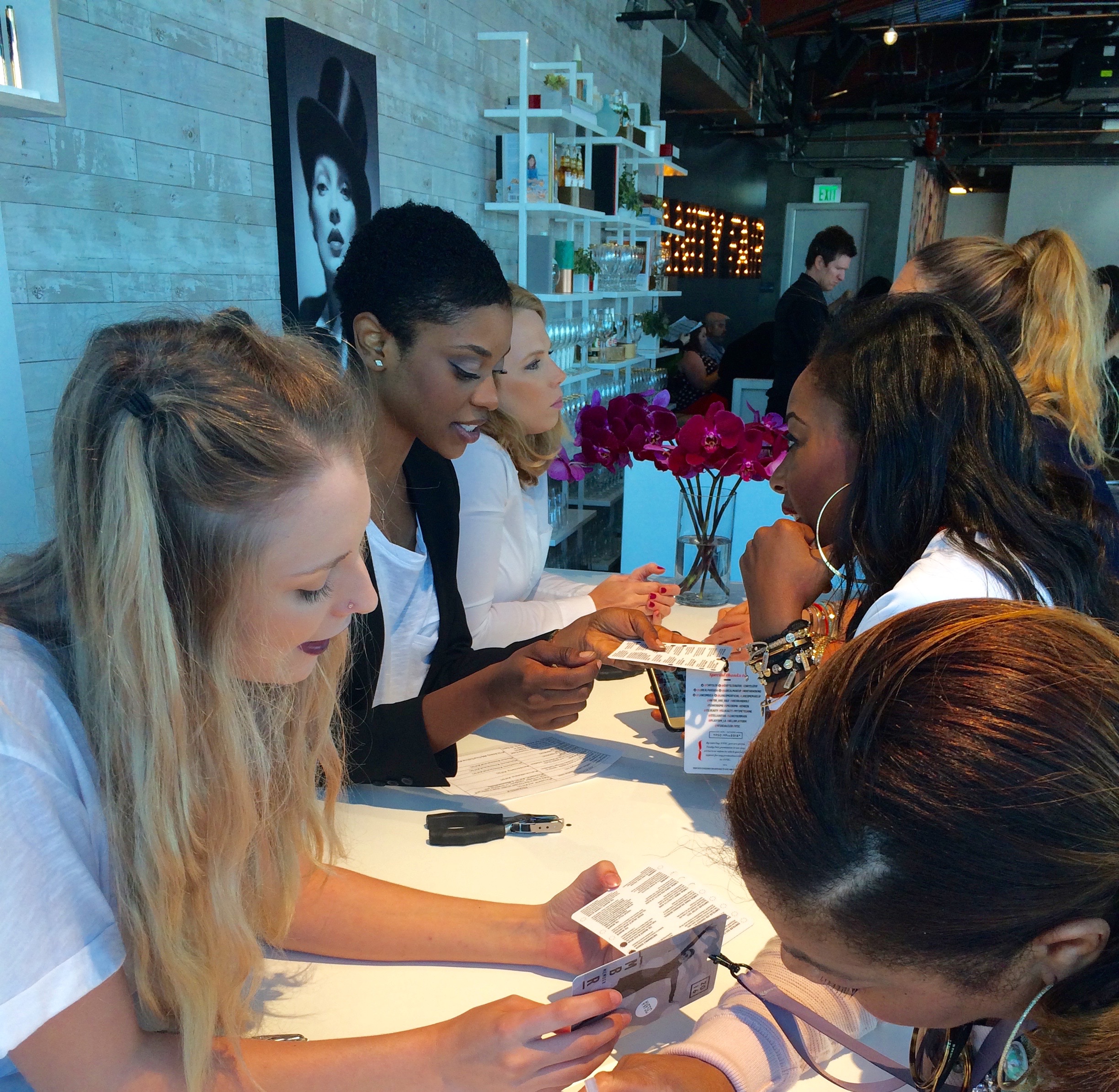 Vanity Fair Social Club attendees choose from an assortment of beauty gifts after tweeting and instagraming the event's sponsored products. (Morgan Evans/Annenberg Media)
Vanity Fair Social Club attendees choose from an assortment of beauty gifts after tweeting and instagraming the event's sponsored products. (Morgan Evans/Annenberg Media)
On a beautiful, crisp Saturday in Los Angeles, Vanity Fair’s Social Club , invited their esteemed club members as well as the press to an afternoon of pre-Oscar beauty panels featuring celebrity makeup artists, stylists, and top influencing bloggers. The minimalistic Culver City studio was decorated to a tee with Vanity Fair custom photo booths sponsored by fashion and fragrance designers like Viktor and Rolf, free beauty makeovers and touch ups sponsored by L’Oreal, hand-crafted cocktails and bites from Lemonade.
The first of the day long panels was titled: “The New Paradigm: The Power of the Social Influencer,” and featured some of social media’s top fashion and beauty millennial influencers, Wendy Nguyen, Andy Torres, Marinna Hewitt and Rocky Barnes.
The famed social media influencers shared with the audience how they use social media to build their brands and what platforms are their favorites.
“My Instagram is super curated I am very specific about the photos that I post. I only post like three colors. On Snapchat I share a lot more,” said Marianna Hewitt of the “Life with Me” blog. Hewitt said she uses her Instagram to share an array of carefully selected, color-schemed photos, her snapchat to share her daily experiences, her YouTube channel to share makeup tutorial content and travel videos, and her Twitter to have conversations with her fans and her followers.
“Every platform has its own purpose and I like them all for different reasons and I feel like I do need all of them,” Hewitt said.
Unlike Hewitt, Andy Torres of the “Style Scrapbook,” had a different approach to Instagram. “Instagram has become so curated that it often shows a side to people that is not sometimes real.”
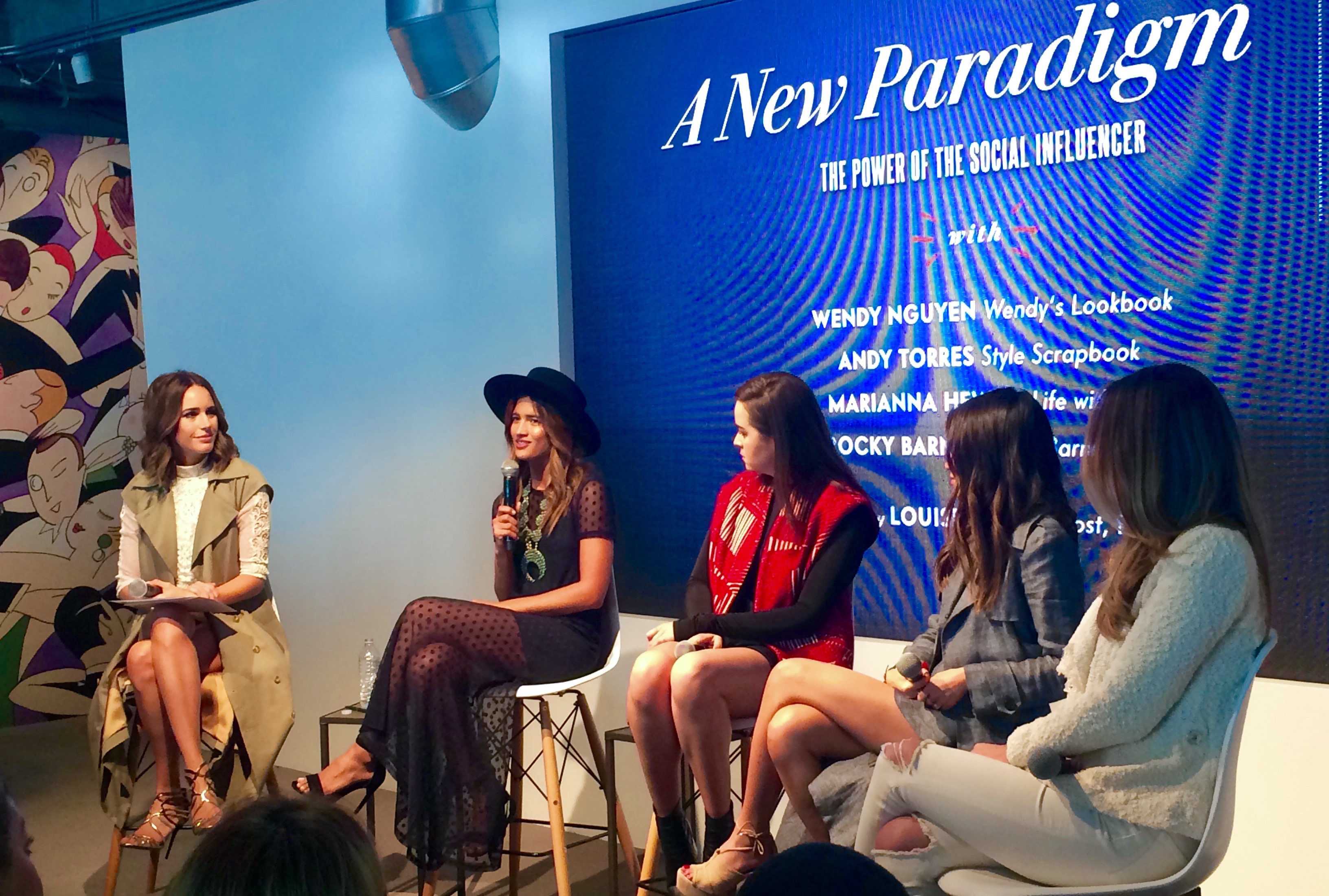 Louise Roe, far left, moderates the Vanity Fair Social Club beauty panel with Rocky Barnes, Andy Torres, Wendy Nguyen and Marianna Hewitt. (Morgan Evans/Annenberg Media)
Louise Roe, far left, moderates the Vanity Fair Social Club beauty panel with Rocky Barnes, Andy Torres, Wendy Nguyen and Marianna Hewitt. (Morgan Evans/Annenberg Media)
Torres, who is more of a lifestyle blogger, decided to start snapchat so that people could have access to her world and her real personality. She admitted to the audience that with staged photos on her Instagram, people assumed that she was a bitch when she met them.
“I really wanted to show people who I am because I don’t like to be judged by the pictures,” Torres said.
“I feel a little different,” said blogger Rocky Barnes. “My Instagram is totally just me. I post like an obnoxious amount – like three or four times a day. So, if you don’t want that, don’t follow me.”
The presence of bloggers and fashion and beauty brands on Instagram and Snapchat is not only growing, they are becoming a prime influence on the fashion and beauty consumer.
“While the beauty industry is still an authority, their messages are now being channeled through independents such as bloggers and online magazines,” Albright said.
After over two decades of working in the beauty industry, Albright said what has changed the most about the industry is the concept of the blogger. And today, millennials have taken over the blogosphere .
“Magazines were a conduit for the assimilation of ideas about beauty. Bloggers create their own space and don’t have to come in with a pedigree of any sort.”
But despite having no real pedigree, Albright admitted the blogger has become the social landscape of the Internet we now accept – especially when it comes to the millennial generation.
“The millennial, like anyone now in the digital age, has a selection of authorities to pick from that never existed before,” Albright said. “Bloggers are this time period’s current form of opinion makers as the way we interact with digital space.”
The blogger has also contributed to the growth of the world’s number one social media platform for millennials, Instagram .
“Instagram has changed the way we view and take in images,” Albright said.
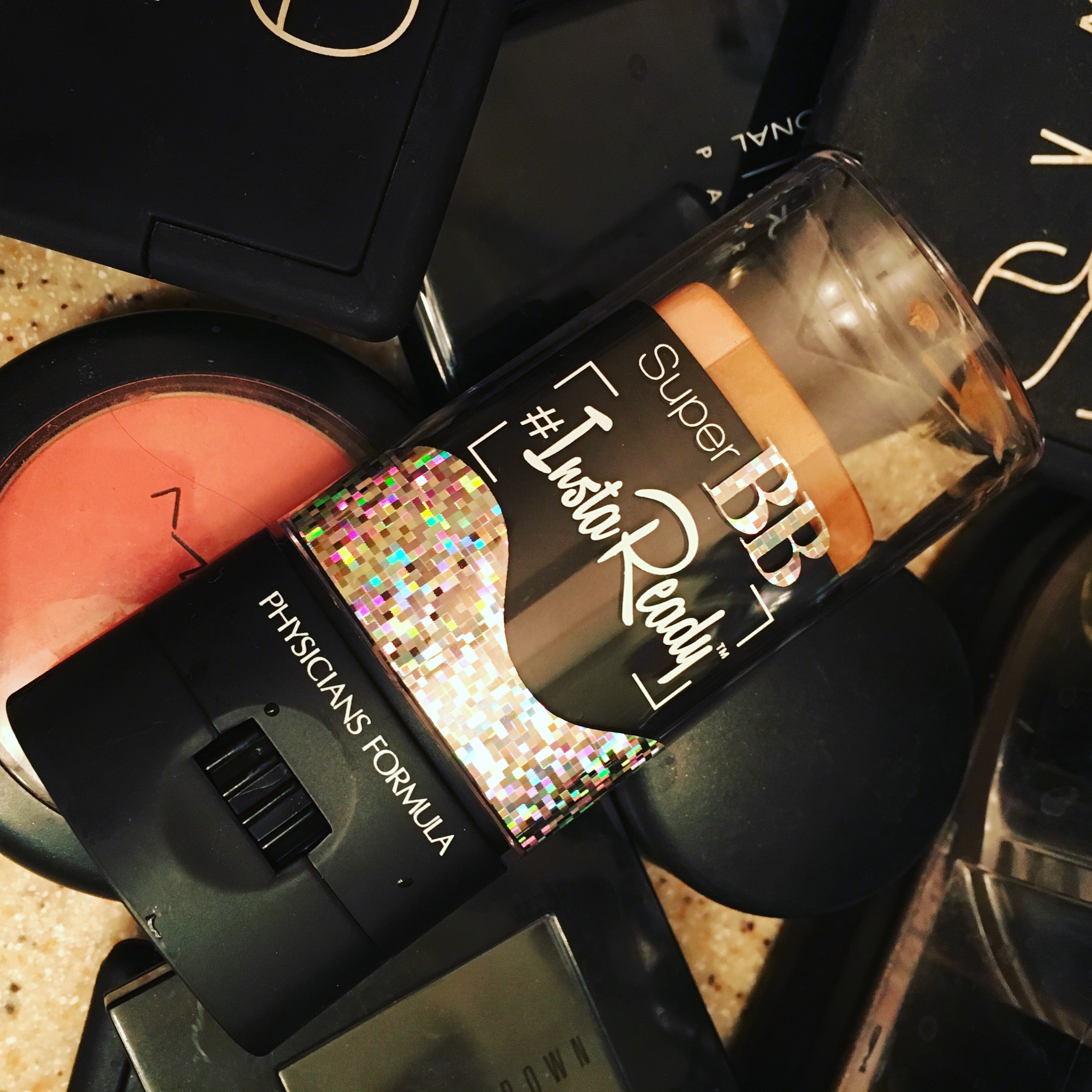 In the height of selfie culture, this Physicians Formula contour stick is just one of the many modern makeup products aiming to help women get "Insta Ready." (Morgan Evans/Annenberg Media)
In the height of selfie culture, this Physicians Formula contour stick is just one of the many modern makeup products aiming to help women get "Insta Ready." (Morgan Evans/Annenberg Media)
Founded in 2010, the photo sharing media platform has not only changed the way society engages with images, it has also redefined the perception of self and beauty. Because millennials have pioneered images like the “selfie,” Albright believes people are “more self-conscious and less self conscious about taking their own images than they ever were before.”
Within a year of its landmark debut, Instagram had already gathered one million users. And with the creation of new filters and new ways to tag and share images, by September of 2015, Instagram celebrated the success of 400 million users world-wide.
But the instant popularization of Instagram has caused a revamp in the way millennials, women especially, take and share photos. Today most Insta pages are staged, like Marianna confessed hers to be. Instagram has created a community where people work to stage perfect photos, creating the allure of how people want to be seen and how people see each other.
“It is narcissism on steroids and it is selfish or selfie,” USC professor Blaine said. “I grew up in the age of photography which has now become exasperated by social media.”
Today, people can purchase followers and buy likes to make it look like significantly more people are looking at them, solidifying that the social construct of Instagram is essentially fake.
“Why do I need to have other people tell me that I am worthy? Things are for sure out of control and it would be hard to be a young girl today,” Blaine said.
Social media has become a form of self validation and people, especially millennial women, are feeling the constant pressure to always look and appear good enough. But even though society knows that most of these pages feature curated images, why does the popularity of beauty on social media continue to grow?
“People look at pictures as permanence. But pictures don’t make you live forever. And then when you start choosing pictures and filtering and photoshopping photos, it’s a highly artificial representation of self. It’s not a mirror, it’s an idea of what you want people to think of you.”
Despite the fact that Instagram may be forcing more women to create that false representation of who they are, the beauty aesthetic of Instagram will always reel the user back in.
And while Instagram and Snapchat may be the most accessible of the popular social media platforms, another platform that has forever changed the way women view beauty is YouTube.
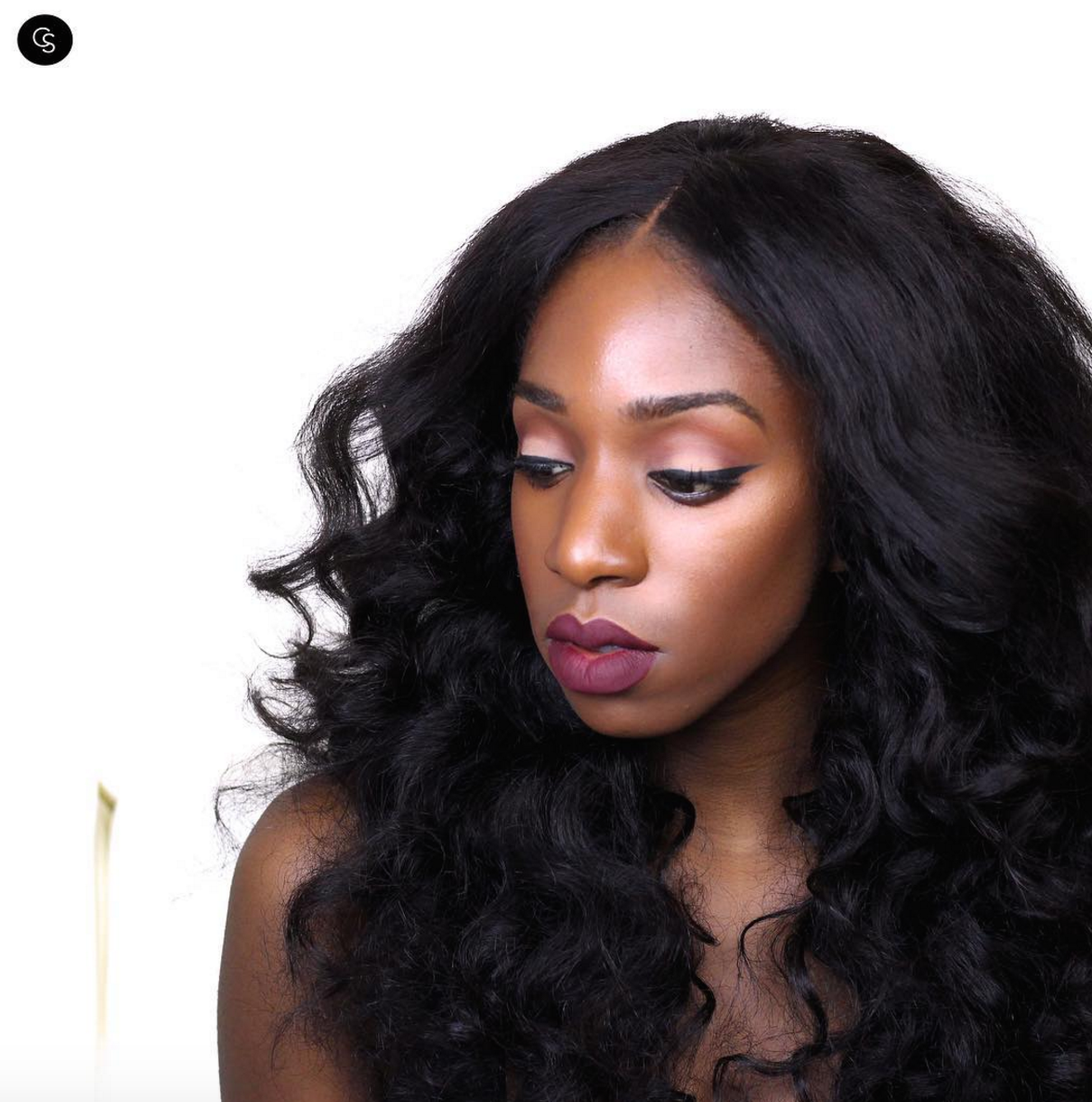 A snapshot of Amaka from her Cocoa Swatches webpage. (Photo courtesy of Ofunne Amaka)
A snapshot of Amaka from her Cocoa Swatches webpage. (Photo courtesy of Ofunne Amaka)
“I think YouTube is still one of the top platforms for the beauty industry,” said Ofunne Amaka, beauty blogger and creator behind the new makeup app and website, Cocoa Swatches.
Originally from the Bay Area, the 26-year-old Columbia University grad was always a beauty lover. Prior to attending graduate school, she created her own beauty diary where she discussed finding the right shades of makeup for brown skinned women. While in grad school, like most students, Amaka became very cognizant of her dollar and also found that she didn’t have the time to find all the makeup she wanted. So, in 2015 she began a beauty Instagram page.
“I was trying to come up with words that allude to brown girls and brown skin and I wanted to focus on swatches and that’s how it came together,” Amaka said.
The “Cocoa Swatches” page is dedicated to helping brown skinned beauties find their desired makeup shades. And while the page gained followers, she felt as though she could take her brand to the next level.
Today, beauty bloggers or vloggers are dominating the YouTube space. Makeup and the art of applying makeup is having a resurgence in today’s millennial driven social media world, through video tutorials and digital platforms such as Instagram. And though, makeup itself has been around for centuries, really wearing makeup and wearing it well – from brow shaping, to check and neck contouring, and over-lip lining and false eyelash styling, has become the elevated way of face painting. Wearing and applying makeup is now a digital experience.
As a one-woman-show, Amaka wanted to find the best way to optimize, quite literally a directory of photos for her makeup page.
“I felt like the website was nice, but it wasn’t going to accomplish what I wanted it too, so I thought an app was the next step that made the most sense.”
After a year of working with a developer service – a Word Press for apps as she calls it, Amaka worked hard to make her Cocoa Swatches vision happen.
In March of 2016, Amaka launched her Cocoa Swatches app and the news was featured in some of the nation’s top female publications such as Seventeen Magazine, Teen Vogue, Allure, and Refinery 29. The app swatches trending cosmetics against darker skin tones. Amaka is looking to build her brand and get the Cocoa Swatches name out there, but she is also looking to add some more diversity into the beauty influencer mix.
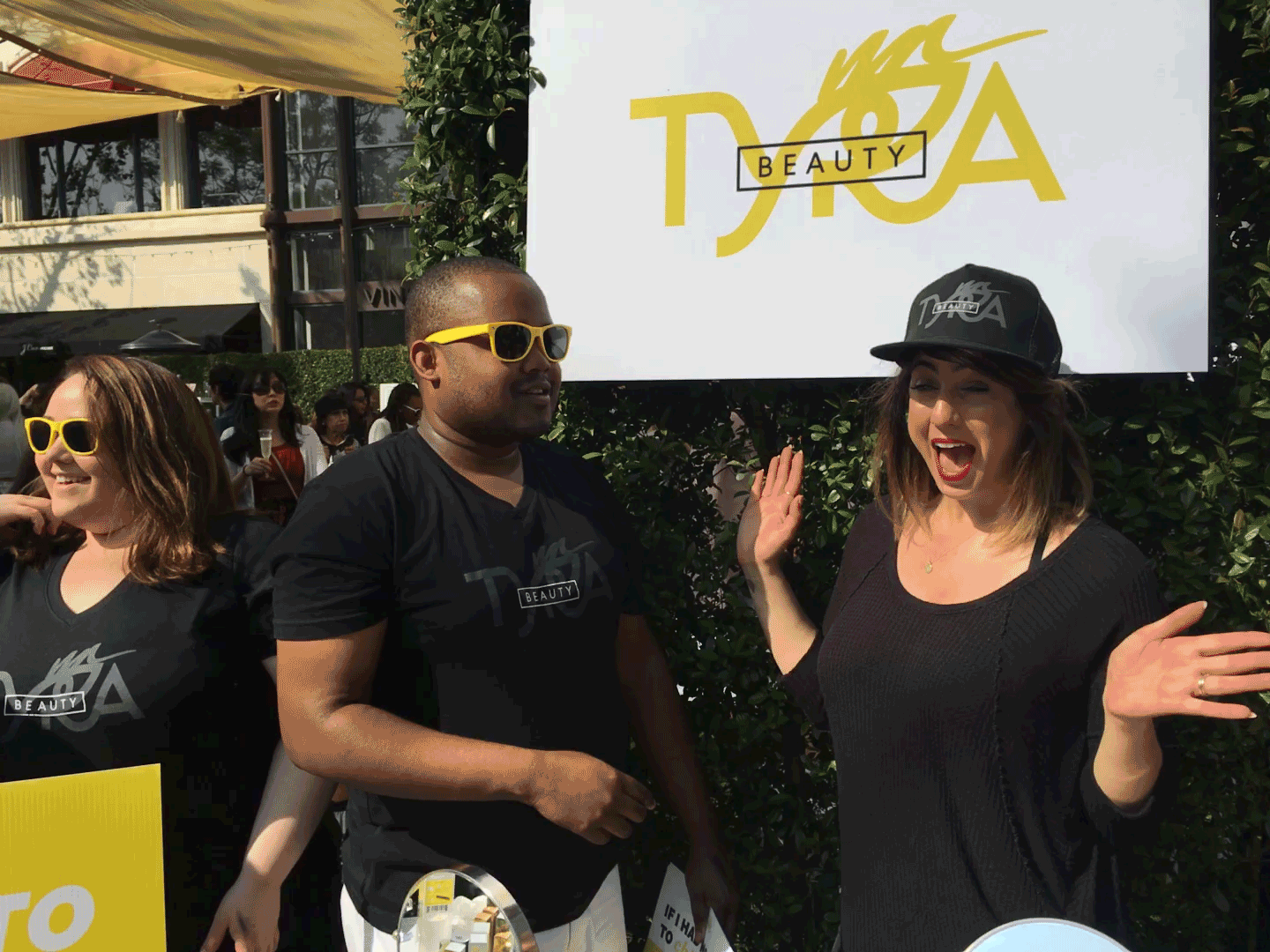 Tyra Beauty sales reps pose in front of the Tyra makeup booth at the Simply Style beauty conference in March. (Morgan Evans/Annenberg Media)
Tyra Beauty sales reps pose in front of the Tyra makeup booth at the Simply Style beauty conference in March. (Morgan Evans/Annenberg Media)
“One of the reasons why I started Cocoa Swatches was because 97 percent of the beauty conversations is controlled by these beauty influencers,” she said. “And I can confidentially say that the majority of these influences are not women of color and I think that’s an issue.”
Amaka points out the small percentage of beauty influencers who are women of color. When it comes to top beauty bloggers and influencers who are not white and are being praised for redefining the digital beauty space, the most talked about influencer is Michelle Phan. Not only does Phan represent the Asian community, she was one of the first YouTube sensations to reach over 1 billion views on her YouTube channel kicking off the beauty vlogger trend.
But apart from Michelle Phan, how is the rest of the world represented?
“If bloggers are having such a great amount of influence and we are not represented, then there is a disconnect there and I think that is where the problem lies,” Amaka said. “And there are a few influencers of color who are doing great things, but it will just be that one influencer every time.”
Make Up Shayla, a former MAC makeup artist turned beauty instagramer, is one of the few African American beauty influencers with over 1 million followers. Shayla also has a popular makeup YouTube channel with over 200,000 subscribers.
“I think that social media will continue to progress and I think the beauty industry will continue to make use of it, but I hope that over time the influencers become more diverse.”
Amaka clarified that she is not trying to become the next Michelle Phan or Make Up Shayla, she is not the makeup tutorial queen, but her goal of Cocoa Swatches is to be one more black voice in the beauty community to help out women of color when they don’t see themselves in the often white-washed range of beauty influencers.
“There’s more than one shade of black you know what I mean? There should be more types of people included,” Amaka said.
It wasn’t always Sheila Nazarian’s dream to become the board certified plastic surgeon that she is today. As a child, Nazarian had an interest in becoming a doctor like her father, but her choice of career was between an orthopedic surgeon and an architect.
“I did wood shop in elementary school and I really liked it, so I thought I wanted to do something with hammers and nails,” she said. “But I decided against architecture because I didn’t want to be behind a desk, I wanted to use my hands.”
Nazarian began her medical career in Orthopedics, but soon found the specialty to be too “cookie-cutter” for her liking. A friend then suggested trying plastics and the rest, as they say, is history.
Today, Narzarian heads her own plastic surgery practice in Beverly Hills and has been featured on outlets such as “Inside Edition” demonstrating some of her unique procedures. And in a field that is heavily dominated by men, Nazarian serves as a prime option for women seeking a female perspective on medical advice and procedures.
“I kind of feel like I was raised as a boy, I don’t know why. I wasn’t a tomboy I did ballet, but no one ever told me you can’t and I didn’t have the personality to doubt myself.”
According to Nazarian, 90 percent of patients seeking plastic surgery are female, and with the media having so much influence on female appearances, one thing Nazarian said she is not seeing in the media are female plastic surgeons.
“What I would like to see is more female plastic surgeons on TV,” she said. “Although shows like “Botched” and “Real Housewives” have made it more acceptable to speak about plastic surgery, there are basically no female plastic surgeons on television.”
Nazarian’s private practice is 95 percent cosmetic and now five percent reconstructive. While she performs full surgeries, Nazarian also does a lot of non-invasive procedures. Her aesthetic for her practice is all about making women feel more confident about their natural looks, enhancing what they have as opposed to making them look like a different person.
At the end of the day, Narazian doesn’t want her clients to look like a fake version of a celebrity. When she operates on a patient, the goal is for that patient to still look like themselves…just a few years younger.
 Samples and testers from the new Tyra Beauty line were on display at the Simply Stylist beauty conference. (Morgan Evans/Annenberg Media)
Samples and testers from the new Tyra Beauty line were on display at the Simply Stylist beauty conference. (Morgan Evans/Annenberg Media)
It's no secret that people pay to look like celebrities. Whether getting plastic surgey or having makeup professionally done, today it is easy for people to replicate their favorite celebrity looks. Social media now allows users to not only tag and post about their favorite beauty products, but their favorite makeup artists as well. Now, the faces behind the celebrity faces are finding themselves in the spotlight. The celebrity squad, or hair and makeup teams, have flourished into popular beauty influencers of their own.
And while the digital space may be lacking diversity in the beauty sector, there is one African-American beauty mogul who is taking over in real time. Celebrity makeup artist and L’Oreal brand ambassador, Sir John Barnett, fell into the makeup industry on accident.
“I was at a photoshoot for a friend of mine who was a model and the makeup artist was unable to make it. So my friend said, ‘Hey can you look in my bag and put together some makeup looks for me?’”
Barnett, who had gone to college for studio art, gave his friend “a basic face,” and the photographer ended up loving the look.
“He asked me to come back the next week for 300 bucks. So, I came back and that was the start of something new.”
But today, Barnett is no longer the new kid on the block when it comes to the makeup artist game. Boasting celebrity clients such as Beyonce and Karlie Kloss, Barnett’s artistry can be seen at the Super Bowl, on the cover of Vogue and on red carpets.
“A great look that I love from the past would have to be Beyonce’s Super Bowl look,” Barnett said. “That was a great moment. Or the the Time Magazine cover.”
John said his favorite thing about working in the industry is being able to impact women’s self worth, but what is his least favorite thing?
“The quick turnover of trends and the lack of diversity in advertising campaigns and across cosmetics companies,” he said.
After a decade in the beauty industry, the 34-year-old makeup artist said that no doubt the top beauty trends for millennials has everything to do with social media.
“I don’t think there is any industry that has been so well impacted by social media as the beauty industry has. We live in a selfie driven nation now. We have makeup that is catered to the selfie and the face tuning,” he said.
Barnett looks at social media as a powerful vehicle for the beauty industry and thinks that it has done some good when it comes the global beauty conversation.
“You can see girls getting dressed at their vanity in Korea, you can see girls getting ready for date night in Dubai – from Harlem to Hong Kong, all of these women, all of these races, all these people come together in all of these walks of life and that happens to be a vehicle of social media.”
 Sir John does Beyonce's makeup before her 2016 Super Bowl performance. (Photo courtesy of Sir John Barnett)
Sir John does Beyonce's makeup before her 2016 Super Bowl performance. (Photo courtesy of Sir John Barnett)
But while there is a lot of good happening on social media, Barnett does feel that there is a lack of diversity when it comes to the beauty blogosphere.
“I don’t see a lot of African Americans, Indians – there are not a lot of people of color doing blogging on that level. But we do need to make sure that we are more represented. But I think the best bloggers, or just across the board in the industry, are those that can impact all races.”
Barnett addressed the irony that while there is a lack of diversity in the beauty world, women of color are constantly, heavily imitated. Ethnic beauty has an over-arching impact on the globalization of beauty. Everything from tanning, to having bigger lips and bigger butts - these are all traits that people of color naturally have and were told to be unattractive. “But now there is a huge mainstream push to emphasize these things,” said Barnett.
And while celebrities are plumping up their lips and making money off their Instagram photos, there is one thing Barnett does admire about the beauty boom on social media and that is the presence of real women.
“Younger celebrities are influencing the way cosmetics are trending, but also the woman who ranks supreme nowadays isn’t necessarily the supermodel or the movie star, but the woman who has other women that can identify with her,” he said.
Barnett expressed that as long as strong-voiced individuals continue to share their stories through personal channels, the more people will follow. Literally.
“It’s not just your story, it’s how well you understand THE story and the story being how the social climate is changing the way we look at beauty,” he said.
What’s stopping millennials from growing their brand and becoming some of the top beauty influencers and bloggers today? Nothing.
“Before there was a preverbal glass ceiling on how much you could get done if you don’t live in New York or L.A., but today millennials can sit in their living room or on the beach and be wildly impactful from anywhere.”
Barnett believes that the future of makeup and the beauty industry in general, is only going to get more social.
"We’re just seeing the beginning of it. I'd love to see the Apple 6, 7 and 8 of what is happening now. We are that pioneering generation.”